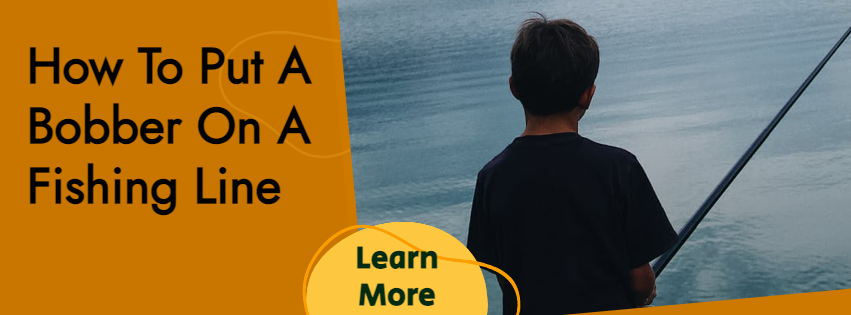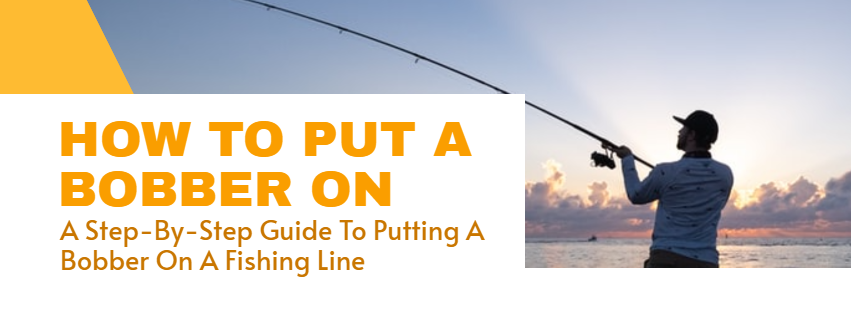A bobber is a device that helps fishermen catch fish. In general, it’s used to let you know when a fish takes the bait. You’ll need a bobber holder to hold the bobber, a bobber, a weight, and a fishing line.

What items do you need to put a bobber on a fishing line?
- Fishing rod
- Fishing line
- weight
- bobber
- fishing bait
Step 1: Tie the knot
To tie a bobber onto a fishing line, start by making a slipknot. Make sure that the loop doesn’t tighten too much because it could break the fishing line. Once you’re satisfied with how tight the knot is, tie another knot around the first one.
Before you connect anything at the end of your line, have it hooked properly. Choose a line designed for the sort of water you’re fishing in. Spool the line onto the reel first, then through your rod. Run the line through all of the guides to ensure a consistent cast.

Step 2: Attach the bobber
Next, take the bobber and thread it through the hole in the middle of the bobber holder. Then, slide the bobber down into the bottom part of the holder. Finally, wrap the fishing line around the bobber holder and pull it up until it reaches the top part of the holder.

Press the piece of plastic on top of the bobber to release a little clip on the bottom of the bobber. Thread the line through the clip and pull it tight. The bobber’s bottom is now attached to the line.
Press down on the outside edge of the plastic piece on top of the bobber with your finger where the line is joined to the bottom of the bobber. This will disclose a little clip, similar to the one on the bobber’s bottom. Thread the line through the clip and pull it tight. The bobber is now connected to the line.

Step 3: Add the weight

Now, add the weight to the end of the fishing line. Take the hook out of the bobber holder and place it over the weight. Pull the weight toward the bobber holder until it reaches the top of the bobber holder, and then push the weight down until it touches the bobber.
Weight of sinkers:
For shallow water, use an 1/8 ounce (3.5 g) sinker.
Use a 1//4-38 oz (7.1-10.6 g) sinker in deeper water.
Optional Stop Bead:
A stop bead is the next thing to add to your mainline. It is not always required to use a bead, but it is totally dependent on the insert diameter of your slip bobber.
If the diameter is quite tiny, the bobber stop will be completely sufficient to stop the bobber. If it is too large, the bobber will just glide right past the stop since it is too little. That’s when you put in a larger stop bead!

Watch video demo here:
Types of fishing bobbers according to water type:
Fishing Bobbers for Freshwater Fishing
A bobber is a device for fishing which floats on the surface of the water. It helps anglers determine when a fish has bitten, and also when to set the hook.
There are two types of bobbers: floating and sinking. Floating bobbers are typically used in saltwater fishing, while sinking bobbers are used in freshwater fishing to help anglers detect fish bites at greater depths.
The design of a fishing bobber can vary greatly depending on its intended use, but they all share one common feature: they float on top of the water’s surface.
Fishing Bobbers for Saltwater Fishing
A fishing bobber is a device that floats on the surface of water and is used to indicate whether fish are biting. The bobber’s buoyancy is adjustable by adding or removing air from it with a hand pump. Fishing for saltwater fish can be done with different types of fishing bobbers.
In this section, we will discuss the different types of fishing bobbers that are used for saltwater fishing, as well as how they work and what they’re best at catching.
Pencil Bobbers
Pencil bobbers are easy-to-use fishing tools that are sensitive enough to catch small fish. But how do you know what size bait to use? We asked our friends at Fishing Tackle Warehouse about it. Here’s what they had to say.

Because pencil bobbers are light, tiny motions drag them under. Pencil bobbers have long tips that protrude from the water and are more likely to tilt or sink when a fish bites. Push the spring on the end of the pencil bobber up to expose the hook below. Before releasing the spring, wrap your fishing line around the hook 2-3 times.
1. Size matters.
The best way to determine what size bobber you need is to measure the diameter of the hook shank. A good rule of thumb is that the larger the diameter, the bigger the bobber. For example, a 3/0 hook needs a bobber that’s 2 inches long; a 4/0 hook requires a bobber that is 3 inches long; and a 5/0 hook needs a 4 inch bobber.
2. Get a feel for the water.
If you want to go big, try a 10-inch bobber. If you prefer something smaller, a 7-inch bobber might work better. You can always add another layer of protection later.
3. Go shallow.
A bobber that’ll fit a 3/0 hook is too large for most bass. Instead, look for a bobber that fits a 3/0 hook that’s no longer than one foot deep. This keeps the lure closer to the surface, where bass tend to hang out.10 of 12:Use a transparent bubble bobber to avoid spooking fish.
A bubble bobber looks like a floating object, so fish won’t spot it. This makes it ideal for catching baitfish and other small game fish. But you’ll want to use one carefully because it could scare off larger prey.
The best way to do this is to attach a transparent bubble bobber near the surface of the water. This allows the fish to see the bobber without being startled. You can make your own bubble bobber out of plastic tubing, PVC pipe, or even a clear soda bottle. Just cut off the bottom half of the bottle and tape it together. Then fill it with air and tie the end closed. To prevent snags, add some fishing line to the inside of the tube.
You can find many online retailers selling bubble bobbers, including Amazon, eBay, and Walmart.

What Is a Fishing Bobber?
Bobbers come in different sizes, shapes, materials, colors, and prices. They range from inexpensive plastic models to custom-made ones crafted from wood, aluminum, brass, stainless steel, copper, and even gold.
Some bobbers are designed specifically for bass fishing; others are used for catching trout or walleye. Regardless of the type of bobber you choose, it’s always good practice to check the manufacturer’s instructions for proper use.
How Do I Choose My Bobber?
The first thing to consider when choosing a bobber is the depth of the water where you intend to cast. If you’re planning to go deep-sea fishing, you’ll probably need a heavy-duty model. On the other hand, shallow lakes require lighter, smaller bobbers.
Next, think about the length of the rod you plan to use. For example, if you’re using a spinning rod, you’ll likely want a bobber that’s long enough to reach the end of the rod. In addition, make sure that the bobber doesn’t interfere with the action of the reel. Finally, take into account the weight of the lure you plan to use. Heavy lures require heavier bobbers.
How Do I Attach A Bobber To A Fishing Pole?
To attach a bobber to a fishing pole, you will need to tie the bobber onto the fishing line using a knot. The most common knot to use is the clinch knot. Once the bobber is tied onto the fishing line, you can then thread the line through the eyelet on the pole and secure it with another knot.
How to tie the bobber onto the fishing line
To tie the bobber onto the fishing line, start by threading the line through the hole in the bobber. Then, tie a knot around the bobber, making sure it’s tight. Finally, cut off any excess line.

